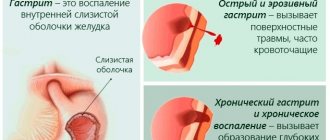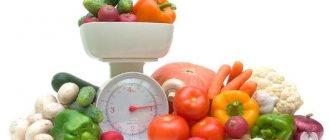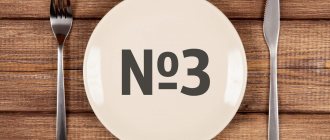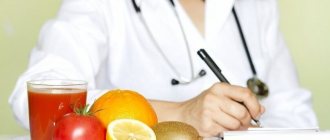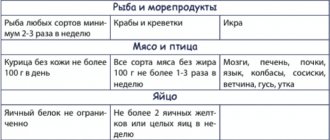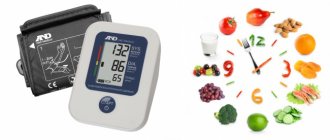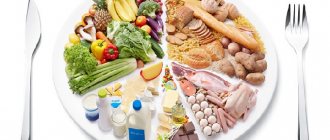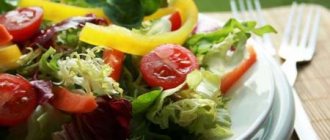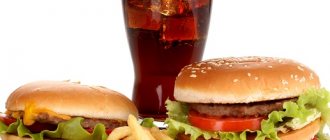Recommendations from nutritionists for patients with type 2 diabetes
Proper nutrition helps normalize metabolic processes and blood sugar levels.
A person suffering from changes in metabolic processes is recommended to:
- steam food, boil it, bake it in foil, stew it;
- Divide the daily food intake into 5 - 6 parts, make healthy snacks (fresh fruits, dairy products);
- exclude sweets, white bread, pastries;
- give up fatty, spicy foods, alcohol;
- use sweeteners;
- eat fruits, berries, root vegetables and vegetables raw;
- increase the amount of proteins, reduce the amount of carbohydrates in food.
Diet 9: Advantages and Disadvantages
The advantage of diet No. 9 is a balanced diet that includes all the nutrients the body needs. The fact is that the amount of carbohydrates and fats is reduced, but not so radically, so the diet can be used for quite a long time. For people who are overweight, doctors recommend following the diet throughout their lives. For many, diet 9 may seem inconvenient and complicated, due to the fact that most of the dishes need to be prepared, then counted and measured out the required amount of food. But these disadvantages are compensated by the ability to safely and gradually lose weight, maintain weight steadily, and control blood sugar levels.
Recommendations from nutritionists for those who want to lose weight
Table 9: The diet has been successfully used for weight loss by healthy people. The weekly menu remains the same as for patients with diabetes.
To lose weight, doctors advise:
- eat in small portions;
- exclude sugar and flour;
- do not add salt to prepared dishes;
- give up alcohol - it slows down metabolism;
- Eat “fast” carbohydrates in the morning, don’t skip breakfast;
- drink plenty of fluids (2 liters per day);
- find replacements for unhealthy treats;
- eat slowly, chew food thoroughly.
The essence of the diet
In diabetes, the body does not produce insulin, a hormone that helps glucose enter cells and provide them with the necessary energy. Table No. 9 sets itself the obligatory task of normalizing blood sugar levels. In addition, the therapeutic diet:
- Prevents lipid metabolism disorders;
- Determines carbohydrate tolerance (how much is absorbed);
- Controls protein, water-salt and carbohydrate metabolism;
- Relieves swelling;
- Stabilizes blood pressure.
For type 1 diabetes, just a healthy balanced diet is enough and you don’t have to adhere to strict restrictions. Diet 9 is rather designed for people with type 2 diabetes. While the use of insulin is not yet indicated for the patient, preventive and health-improving nutrition is the only means of treatment.
Table number 9 has a moderately reduced energy value of 2300-2500 calories due to the exclusion of fast carbohydrates from the menu and the limitation of fats, while the amount of proteins remains the same as with a normal balanced diet.
Chemical composition of the diet:
- Carbohydrates – 280-350 grams;
- Proteins – 90-100 grams (40% plant origin);
- Fats – 75-80 grams (75% animal origin).
The diet for type 2 diabetes allows up to 10 grams of table salt in the daily diet.
The daily volume of free fluid should be at least 1.5 liters. Dehydration can cause your blood sugar levels to rise.
Diet No. 9 according to Pevzner has been carefully developed and tested in use; its menu is nutritious and complete. The health nutrition system is so gentle that it can be safely used on children and pregnant women.
Table No. 9 is useful not only for diabetes types 1 and 2; a healthy diet can be followed for various forms of allergies, polyarthritis, rheumatism, bronchial asthma and diathesis.
Authorized Products
| Bread | Whole grain, bran |
| Cereals | buckwheat, oatmeal, millet, pearl barley |
| Pasta | from unprocessed wheat varieties, bran |
| Meat | tender veal, rabbit, lamb |
| Bird | chicken, turkey |
| Fish, seafood | shrimp, cod, bream, perch, carp |
| Vegetables | green vegetables, tomatoes, carrots, bell peppers, eggplants, pumpkin, greens |
| Fruits, dried fruits | apples, pears, peaches, apricots, citruses, sour berries, dried apricots, prunes |
| Milk, dairy products | skim milk, kefir, cottage cheese, soft cheese, yogurt without sweeteners |
| Sweets | dietary, sorbitol/xylitol - marmalade, marshmallows, pudding |
| Beverages | tea drinks with herbal additives, coffee, sour compote, juice, fruit drink, decoctions of herbs, berries, mineral water |
Diet 9 table for type 2 diabetes mellitus: menu for the week
The 9 table diet has long been proven effective for type 2 diabetes mellitus. We present to you the menu for a week for type 2 diabetes, as well as nutritional principles, a list of foods allowed and prohibited for consumption!
Diet No. 9 for type 2 diabetes
To adjust the intake of carbohydrates, patients are prescribed a special diet. The key to treating diabetes is to eat foods with minimal carbohydrates and fats. If all conditions are met, the indicators stabilize to 5.5 mmol/l and metabolism is restored.
Principles of nutrition for patients with type 2 diabetes
Daily caloric intake is calculated in accordance with energy needs, on average it does not exceed 2200 kcal. Overweight diabetics reduce their daily calorie intake by 20%. You should drink a lot of clean water throughout the day.
What you can and cannot eat
To provide the body with vitamins and minerals, various foods are included in the diet, but which do not cause a surge in insulin. Every diabetic knows which foods to avoid.
List of prohibited products:
- seasonings:
- alcohol, beer, soda;
- vegetables – beets, carrots;
- high fat dairy products;
- fatty poultry, fish;
- canned and smoked foods;
- rich broths;
- feta, curd cheese;
- mayonnaise, sauces.
- Dessert;
- fast foods.
List of foods for the diet:
- dairy products with fat content up to 2.5%;
- pumpkin, bell pepper, potatoes - no more than 2 times a week;
- cereals, durum pasta.
- asparagus, cabbage, tomatoes, cucumbers, greens;
- lean meat;
- mushrooms;
- avocado;
- whole wheat bread.
For appetizers, seafood salads, vegetable caviar, jellied fish, and beef jelly are allowed. Unsalted cheese contains no more than 3% carbohydrates, so it is also included in the menu for diabetics.
Drinks include: teas, coffee, vegetable smoothies or juices, berry fruit drinks, compotes. Instead of sugar, acesulfame potassium, aspartame, sorbitol, and xylitol are used.
Vegetable oils and melted butter in minimal quantities are suitable for cooking.
Is it possible to eat fruits and berries?
Previously, it was believed that fruits should be completely excluded from the diet of diabetics due to their fructose content. Today doctors say the opposite. Moderate consumption of sweet and sour fruits is extremely beneficial. However, some types with high GI are prohibited from consumption. This:
- grape;
- dates;
- apricots;
- figs;
- bananas;
- watermelons;
- cherries.
Good for diabetics - kiwi, grapefruit, quince, tangerines, apples, peaches, pears. No harm - pineapples, papaya, lemons, limes. Berries eaten include gooseberries, currants, cherries, strawberries, and blueberries.
They will saturate the body with vitamins - chokeberry, viburnum, Goji berries, sea buckthorn, rosehip infusions. The fruits are consumed in their natural form or fruit drinks are prepared from them.
Juicing is only allowed from vegetables.
Are grains good for diabetes?
- Buckwheat is valued for its ability to satiate for a long time and maintain stable glucose levels.
- Oats contain plant inulin, an analogue of the hormone. If you constantly eat oatmeal for breakfast and drink an infusion from it, the body's need for insulin will decrease.
- Barley groats are dietary products that slow down the absorption of simple sugars.
- Nutritious porridges are made from pearl barley and crushed corn They contain a lot of fiber and minerals (iron, phosphorus), which replenish the body's daily needs.
- Millet is rich in phosphorus, contains fatty acids, B vitamins, and complex carbohydrates. It is prepared with water, with pumpkin and consumed with kefir.
- Flaxseed porridge “Stop Diabetes” with Jerusalem artichoke, burdock, cinnamon, onion, and a mix of the above grains was created specifically to reduce blood glucose.
What are the benefits of legumes?
Lentils are a dietary product rich in amino acids, vegetable protein, vitamins B, A, and PP. The grains are well digestible.
Beans, chickpeas, peas, beans, soybeans are rich in proteins, plant enzymes, vitamins P, fiber and pectins. They remove heavy metal salts. Carbohydrates are easily utilized by insulin. The main thing is not to exceed the norm. If you have colitis or problems with the gastrointestinal tract, it is better to avoid legumes.
Recommended servings in grams
The amount of soup is 200 ml, meat - 120, side dish - 150, berries - 200, cottage cheese - 150, kefir and milk - 250, cheese - 50. You are allowed to eat a slice of bread three times a day, 1 large fruit.
To satisfy the feeling of hunger in the pauses between meals, you can drink a glass of yogurt or curdled milk with bran bread, eat a handful of nuts, 5 pieces of dried apples, or a vegetable salad with a small amount of olive oil.
Sample menu for type 2 diabetics
The amount of BJU (proteins, fats and complex carbohydrates) is balanced. Diet No. 9 implies the consumption of up to 350 g of carbohydrates, 100 g of proteins, 70 g of fats, of which 30% are vegetable.
Monday:
- 1 breakfast - oatmeal with milk + 5 g butter.
- Lunch - fruit.
- Lunch - pearl barley mushroom soup, vegetable salad with boiled or baked fish.
- Afternoon snack - toast with whole grain bread and avocado.
- Dinner - boiled breast with buckwheat and salad.
- At night - kefir.
Tuesday
- 1st breakfast - Millet porridge + rosehip infusion.
- Lunch - Boiled pumpkin with chopped nuts.
- Lunch - Pickle with kidneys, baked potatoes with stewed meat in their skins, salad with seaweed.
- Cottage cheese casserole + kiwi.
- Shrimp with salad or squid stuffed with vegetables.
Wednesday
- 1st breakfast - Buckwheat porridge + tea or rose hips.
- Lunch - Steamed quince.
- Lunch - Chicken soup, baked broccoli with eggs in the oven.
- Cottage cheese + 50 g nuts + green apple.
- Seafood salad or with cod and vegetables.
- Berry juice.
Thursday
- 1 breakfast - A slice of cheese + flaxseed porridge for diabetics.
- Lunch - Unsweetened yogurt without berries + 3 walnuts.
- Lunch - Pumpkin soup, chicken with barley, lettuce + arugula + tomatoes + parsley.
- Black bread with eggplant-squash caviar.
- Beef liver in tomato sauce with buckwheat, a serving of cabbage salad.
- Vegetable juice.
Friday
- 1st breakfast - Lazy dumplings.
- Lunch - Diabetic cake with bran and sorbitol.
- Lunch - Vegetarian soup, cabbage rolls with lean beef and rice, green salad.
- Dietary pudding made from zucchini, apple, milk and a spoonful of semolina.
- Baked meat with any side dish or steamed chicken balls.
- Fermented milk product.
Saturday
- 1st breakfast - Omelet with spinach.
- Lunch - Cheesecakes in the oven.
- Lunch - Pike perch fish soup, seafood cocktail with salad.
- Fruit jelly.
- Ratatouille + beef stew.
- Ryazhenka.
Sunday
- 1st breakfast - Potato zrazy.
- Lunch - Cottage cheese + apple.
- Lunch - Vegetable soup with meatballs, chicken breast with champignons.
- Green bean stew with nuts.
- Meatballs in tomato sauce with garnish.
- Sour fruit.
Having become familiar with the principles of the diet and having studied the list of recommended products, you can create a menu yourself. The main thing is not to overeat and adhere to the specified norms. Although a low-carb diet requires you to give up your favorite foods, it is quite varied and tasty.
Considering that taste habits change quickly, after 1-2 months patients get used to the new regime and control sugar with the help of nutrition.
Source: https://devoe.ru/diety/dieta-9-stol-pri-saxarnom-diabete-2-tipa-menyu-na-nedelyu/
Prohibited Products
| Bread and pastries | white loaf, sweet buns, pies |
| Cereals | semolina, rice |
| Meat, poultry | fatty pork, concentrated meat broth, duck, goose |
| Fish, seafood | trout, salmon, caviar |
| Vegetables | salted, pickled canned food |
| Fruits, dried fruits | banana, grapes, figs, raisins, dates |
| Milk, dairy products | cheese, cream, yoghurt with sweeteners, curd and curd mass |
| Sweets | jam, marshmallows, candies |
| Beverages | sweet, carbonated, alcohol |
| Spices, seasonings | salt, hot spices, flavor enhancers |
Prohibited or partially restricted products
When using the “Table No. 9” diet, the following products should be excluded, in whole or in part, from the diet of a patient with diabetes:
- Sweets and pastries: cakes, pastries, jam, candies, ice cream.
- Duck and goose fillet products. Fatty fish. Smoked products. Sausages. Fish caviar.
- Sweet dairy products: curd cheeses, yoghurts. Ryazhenka, baked milk and cream. Milk porridge.
- Cereals (rice, semolina) and pasta.
- Some types of fruits: bananas, figs, grapes and raisins.
- Pickled and salted vegetables, spicy and spicy snacks.
- Alcohol, store-bought juices, cocktails, coffee.
The group of conditionally permitted foods of the “Table No. 9” diet includes those that are permissible only for mild type 1 diabetes: watermelon, melon, dates, potatoes, beef liver, coffee drinks and spices (horseradish, mustard, pepper). They should be consumed in limited quantities and only after consultation with your doctor.
Conditionally permitted food products
Table 9 contains a number of foods that are limited in the diet. To diversify the menu for the week, you need a doctor's permission.
If there are no contraindications, add to the main ingredients:
- low fat sour cream - 50 gr. in a day;
- herbal and taiga honey - 35 gr. in a day;
- nuts - almonds, cashews, pecans;
- melons - watermelon, melon;
- beef liver;
- egg - 1 pc. in a day.
Such products are allowed for people with mild diabetes who are not dependent on insulin.
For what diseases is it prescribed?
Diet table 9 is mainly prescribed if a person has type 2 diabetes. The disease is characterized by a lack of absorption of insulin produced by the pancreas (unlike type 1 diabetes, in which insulin is not produced at all).
The pathology is incurable, the patient is prescribed constant use of glucose-lowering drugs, as well as a diet. The essence of the diet is to reduce the consumption of carbohydrates - simple and complex.
The presented diet is prescribed not only for diabetes. Doctors often recommend a developed diet for patients with the following problems:
- atherosclerosis;
- fatty liver;
- kidney damage;
- increased glycogen content in the liver.
In addition, the diet in question helps reduce appetite by preventing a sharp increase in blood glucose levels. This helps to reduce excess weight.
The foods contained in the diet regulate metabolism, which is why there is a natural prevention of gaining extra pounds.
Sample menu for the week
Table 9 is a diet whose weekly menu can be varied and easy to follow. Dishes for him are prepared in a gentle way, without losing taste and benefits. Each meal can be replaced with a similar one from another day, creating different menu combinations.
Monday:
- breakfast - cottage cheese with fruit (peach, pear) - 250 g, chamomile tea - 200 ml;
- brunch - boiled egg without shell - 1 pc.;
- lunch - green soup with young nettles - 150 ml, steamed cod cutlets - 150 g, stewed green beans - 100 g;
- afternoon snack - berries (cherries, gooseberries, currants, blueberries) - 150 gr.;
- dinner - chicken meatballs - 150 gr., salad of apple, cucumber and herbs - 100 gr., unsweetened compote - 1 tbsp.
Tuesday:
- breakfast - steamed oatmeal with dried fruits (dried apricots, pear) - 250 gr., coffee with low-fat milk - 1 tbsp.;
- brunch - apricot - 3 pcs.;
- lunch - stew of green vegetables with meat (lamb, rabbit, chicken) - 250 g, fruit jelly with sweetener - 100 ml;
- afternoon snack - kefir - 220 ml;
- dinner - chicken bigos - 230 gr., sour berry fruit drink (red currants, gooseberries) - 230 ml.
Wednesday:
- breakfast - white omelette - 1.5 eggs, grilled tomato - 1 pc., kombucha infusion - 200 ml;
- brunch — rosehip infusion — 230 ml;
- lunch - vegetarian cabbage soup - 150 ml, boiled veal - 120 g, steamed vegetable cutlets - 150 g;
- afternoon snack - salad of fruits and berries (apple, avocado, orange, cherry, blueberry) - 150 g;
- dinner - steamed shrimp - 200 gr., grilled asparagus - 100 gr., kiwi and apple nectar - 240 ml.
Thursday:
- breakfast - buckwheat with milk - 220 gr., tea marmalade - 40 gr., coffee - 1 tbsp.;
- brunch - dietary Varenets - 160 ml;
- lunch - creamy root vegetable soup - 150 ml, peppers baked in foil - 200 g;
- afternoon snack - fruit jelly with sorbitol - 120 g;
- dinner - baked zucchini with cottage cheese - 200 g, boiled fish - 100 g, green tea - 1 tbsp.
Friday:
- breakfast - bran with low-fat yogurt/kefir - 200 gr., quince - 1 pc., herbal decoction - 1 tbsp.;
- brunch - fruit and carrot salad - 150 gr.;
- lunch - dietary borscht - 150 ml, casserole with mushrooms and eggs - 220 g;
- afternoon snack - dietary pudding - 150 g;
- dinner - turkey stew with kohlrabi - 250 gr., berry juice - 1 tbsp.
Saturday:
- breakfast - cottage cheese - 200 gr., low-fat sour cream - 25 gr., fruit tea - 1 tbsp.;
- brunch - pear - 2 pcs.;
- lunch - fish soup - 150 ml., ratatouille - 250 gr.;
- afternoon tea - kefir - 220 ml;
- dinner - boiled lamb - 100 gr., grilled vegetables - 150 gr., compote - 1 tbsp.
Sunday:
- breakfast - squash caviar - 120 g, whole grain toast - 1 piece, homemade meat pate - 50 g, rosehip decoction - 1 tbsp;
- brunch - cottage cheese baked with apricot - 160 g;
- lunch - cream soup of mushrooms and broccoli - 170 ml, boiled chicken breast - 100 g, vegetable of your choice (tomato, cucumber, bell pepper, herbs) - 150 g;
- afternoon snack - pear - 2 pcs.;
- dinner - vinaigrette - 100 gr., rabbit baked with herbs - 120 gr., mashed potatoes - 100 gr., tea - 1 tbsp.
Foods that are prohibited when following diet number 9
Products that are not recommended are prohibited when following the table 9 diet:
- Pastry products, fresh pastries, cakes and pastries with rich cream, puff pastry cookies.
- Soups and borscht made from fatty meats and fish.
- Fatty meat from pork, beef, lamb, animal fat.
- Fatty fish such as mackerel, herring and others.
- Smoked products.
- Salted and pickled foods.
- Cheeses with a high fat content, sweet curd masses.
- All types of pasta, semolina, rice and dishes made from them.
- Ice cream, jam, confiture, sweets, chocolate.
- Carbonated sweet drinks.
- Dates, raisins, dried apricots, grapes, bananas.
What can you eat if you have diabetes:
- Bread made from first-grade rye and wheat flour and coarse grinding, even better whole grain, up to 300 grams per day.
- Lean meat from pork, beef, chicken, turkey, rabbit. Very rarely, a small amount of liver is allowed.
- Boiled varieties of sausage products.
- Low-fat fish; canned fish in its own juice or tomato sauce is allowed.
- Several eggs a day, in any form except fried.
- All dairy and fermented milk products with the lowest percentage of fat content. The use of sour cream is extremely rare. The consumption of cottage cheese is especially welcome.
- Various whole grains. Porridge made from oatmeal, buckwheat, millet, you can bake pancakes and pancakes, but only from buckwheat flour, very tasty and healthy for diabetics
- Vegetables with low carbohydrate content - pumpkin, squash, zucchini, cucumbers, tomatoes, cabbage. Carrots, beets, potatoes are limited due to their high carbohydrate content.
- Almost all fruits are allowed, with the exception of grapes, pears and bananas.
- Berries such as blueberries, cranberries, gooseberries, currants, actinidia, blueberries are especially useful. Scientists have proven that when consumed by diabetics, 20-22 g per day of this berry reduces blood sugar levels.
- Sweet dishes prepared without the use of sugar.
- There are various drinks that do not contain pure sugar. Coffee, tea, low-fat milk, unsweetened herbal and rosehip infusions.
- Unsalted animal butter and all vegetable oils.
If you have type 2 diabetes, watermelon should absolutely not be consumed as it is the second product, the first product is sugar-100, high glycemic index - 97.
The recommended daily caloric content of such a diet for diabetics can be no more than 2300 kcal per day. Diet: 5-6 times a day.
To combat type 2 diabetes, you need to exclude only 7 foods with the highest glycemic index from your diet. They are also called easily digestible carbohydrates:
- Alcohol, vodka, etc.;
- Rice;
- Sugar, sweets, etc.;
- Carrot;
- Potato;
- Beetroot;
- All flour is made from white flour.
Interestingly, blueberries in a dose of 20 grams 2 times a day can reduce glucose levels and increase cell sensitivity to insulin. And the essence of type 2 diabetes is that glucose enters the blood after eating, and insulin does not penetrate the cell, and blueberries increase sensitivity to insulin.
Interesting! A very serious study was conducted that when healthy volunteers were given from 0.5 to 4 teaspoons of cinnamon. After 40 days, the result was such that blood glucose levels and bad cholesterol levels decreased.
Still interesting! Vinegar also helps lower blood sugar levels.
Sample menu for a diabetic diet
1st breakfast:
- Millet porridge with milk, seasoned with butter,
- a piece of curd cheese,
- bran bread,
- coffee with milk.
2nd breakfast:
- Yogurt,
- apple.
Dinner:
- Rabbit soup with buckwheat,
- steamed fish
- jacket potatoes,
- cabbage and cucumber salad with corn oil.
Afternoon snack:
- Cottage cheese casserole,
- orange.
Dinner:
- Boiled vegetable salad,
- fish balls,
- cottage cheese,
- tea.
Before bedtime:
Kefir product
First course recipes
Soups for dietary nutrition are prepared in a light broth and cooked for a short time. You can add a spoonful of low-fat sour cream to the finished first course.
Cream of mushroom and broccoli soup:
- potatoes - 320 gr.;
- broccoli - 270 gr.;
- medium-sized onion - 1 pc.;
- carrots - 230 gr.;
- fresh mushrooms (ceps, oyster mushrooms, champignons) - 220 gr.;
- sour cream - 15 gr. on a plate;
- water for broth - 1.5 - 2 l.
Table 9. The diet, namely the menu, includes cream of mushroom and broccoli soup.
It is healthy and tastes good. Cut mushrooms and vegetables into strips, divide broccoli into inflorescences. Pour water over the products and cook at moderate boil for 30 - 40 minutes. Serve the soup with low-fat sour cream.
Ear:
- low fat fish (pike perch, perch, carp) - 0.8 - 1 kg;
- peeled celery (root) - 80 g;
- small purple onion - 1 pc.;
- carrots - 180 gr.;
- bay leaf - 3 pcs.;
- greens (marjoram, parsley, tarragon, green onions) - to taste;
- water for broth - 2 l.
Chop onion, celery, carrots. Finely chop the greens. Clean the fish and cut into pieces. Place vegetables in boiling water after 10 minutes. add fish and herbs to the pan. Cook for 10 minutes, then turn off the heat and let the fish soup steep for 15 minutes.
Diet 9 table - what is possible, what is not (table)
From the diet table table 9 for diabetes, it follows which products can be used in the cooking process and which cannot.
| Authorized Products | |
| (can be eaten) |
|
| Prohibited Products | |
| (can't eat) |
|
Blood sugar will be normal!
a simple folk recipe has received scientific confirmation, write down...
Liver - recovers in 2 weeks
If you help her, to effectively restore liver function, take homemade...
Main course recipes
Dietary main courses are prepared from fresh, low-fat ingredients. They are stewed or baked in the oven. To enhance the taste, add fresh chopped herbs.
Ratatouille:
- eggplants - 650 gr.;
- zucchini - 540 gr.;
- sweet paprika - 350 gr.;
- tomatoes - 560 - 600 gr.;
- greens (parsley, cilantro) - half a bunch.
Soak the eggplants in salted water for 30 minutes to remove the bitterness, then rinse with cold water. Cut the zucchini and eggplant into thin slices (up to 0.7 cm), cut the pepper into strips, removing the seeds.
Scald the tomatoes with boiling water, remove the skin, and chop with a blender along with the herbs. Place all types of vegetables in a baking container one by one, pour tomato sauce on top. Cook ratatouille in the oven for 50 minutes. at t 200 °C.
Bigos with chicken:
- chicken breasts - 0.6 kg;
- fresh cabbage - 1 kg;
- small purple onion - 1 pc.;
- carrots - 180 gr.;
- tomatoes - 450 gr.;
- greens (thyme, dill, basil) - a medium-sized bunch;
- vegetable oil for frying - 40 ml.
Cut the breasts into pieces 2 cm wide, chop the cabbage into strips. Cut the remaining vegetables into rings. Finely chop the greens and carrots. Heat the oil in a deep container with a double bottom. Fry the fillet over high heat for 5 minutes, add carrots and onions. After 5 min. Reduce heat to low, add tomatoes and cabbage. Cover the dish with a lid and simmer for 40 minutes.
Stir the finished bigos, sprinkle with chopped herbs, let stand in a warm place for 10 minutes.
Diet characteristics 9
To normalize carbohydrate and fat metabolism, the list of permitted foods can be combined to your liking. This will prevent the dishes from becoming monotonous. It is worth reducing the amount of salt, alcohol and sugar to a minimum . When glucose levels normalize after 2-3 weeks of such nutrition, the doctor will gradually expand the diet, adding 1 unit of bread every week.
Authorized Products
Dishes according to diet 9 should contain as little bad cholesterol and extractive substances as possible, but be rich in fiber, vitamins, and lipotropic components. Without restrictions, you can use everything listed in the table below:
| Low GI foods | Medium GI foods |
| fresh or frozen cranberries, blueberries, lingonberries, blueberries | canned pears and peas |
| grape | oatmeal |
| fresh and canned green peas | bran bread |
| buckwheat | lentils |
| durum wheat pasta cooked al dente | bulgur |
| dried and fresh tomatoes | bran |
| low-fat yogurt without additives | oat cookies |
| milk, low-fat cottage cheese | Wheat flour |
| soy and almond milk | pineapple, banana, papaya, melon, mango, sweet berries |
| apricots | jacket potatoes |
| grapefruits | sprouted wheat |
| pears | sweet potato |
| bitter chocolate | long grain rice |
| eggplant | juices without sugar – cranberry, orange, apple, pineapple, grapefruit |
| cabbage | buckwheat bread |
| nuts | colored beans |
| onion garlic | lactose |
| soybean curd and low-fat cheese | |
| greenery | |
| cucumbers | |
| rice bran | |
| fish fingers | |
| hominy | |
| marmalade and jam (with sugar substitutes) | |
| mushrooms |
Products with borderline GI content
Some foods with an average GI value should be limited, and in severe cases of diabetes should be completely excluded from the diet. A detailed list is presented in the table:
| Fruits and berries | raisin |
| Vegetables | potatoes, sweet corn, beets, turnips, white peas |
| Meat products | beef liver |
| Beverages | coffee with cream, soda, alcohol |
| Spices | mustard, ketchup, horseradish, pepper |
| Dessert | fruit chips, sugar |
| Cereals and pasta | corn, pasta, oat muesli |
| Bakery products and their components | wheat flour, hamburger buns, biscuit, eggs |
What products are prohibited
Diet 9 requires completely eliminating fried foods, fast food, sweet fruits, canned food, full-fat milk, most confectionery products, sweet drinks, and salty vegetables from the diet. It is advisable to avoid canned fish or meat . A more detailed list of prohibited products can be found in the table:
| Vegetables and greens | carrots, horseradish, sugar beets, parsnips, baked pumpkin |
| Fruits | apricots, bananas, watermelon, dates, rutabaga |
| Berries | grape |
| Cereals | semolina, white rice, sago, wheat porridge, corn flakes |
| Flour products | noodles, pasta, wheat bread |
| Desserts and confectionery | ice cream, jams, chocolate bars, sugar jam or marmalade, honey, milk chocolate, candies |
| Dairy | cream, curd masses, glazed curds, full-fat sour cream, fermented baked milk, ayran |
| Fish products | Smoked or salted fish, canned food, cod liver, sardines |
| Meat products | pork, lard, smoked chicken, duck, goose, other fatty meats |
Useful analogues
Most prohibited products can be easily replaced with analogues. For example, use brown or sprouted grains instead of white rice, and replace wheat buns with rye bread. An approximate list of comparable products is presented in the table:
| Prohibited Products | Analogs |
| Corn grits or flakes | Bran |
| Fat meat | Rabbit meat, lamb, turkey, veal |
| Cheeses | Tofu |
| Animal fats for frying | Vegetable fats |
| Simple pasta | Pasta made from durum wheat or wholemeal flour |
| Milk chocolate | Chocolate with 76% cocoa |
| Cakes, sweet desserts | Unsweetened fruits, fruit puree, sugar-free marmalade |
| Mashed potatoes | Sweet potato puree |
Dessert
Table 9 - a diet whose weekly menu prohibits sugar; you can diversify it with dietary sweets. They are sold in the specialty foods section of grocery stores or prepared at home. Sorbitol and xylitol are used to add sweetness.
Pudding:
- green apple - 100 gr.;
- carrots - 100 gr.;
- skim milk - 40 ml;
- peeled wheat flour - 60 gr.;
- beaten egg white - 2 pcs.;
- unsalted butter - 15 g.
Grate the apple and carrot coarsely, pour in the milk and egg whites. Add butter to ingredients, sift flour. The mixture must be thoroughly mixed and placed in a baking dish. Bake the pudding in the oven for 25 minutes. at t 180 - 200 °C.
Tea marmalade:
- dry hibiscus tea - 50 g;
- gelatin - 30 g;
- sorbitol/xylitol - 1.5 - 3 tsp;
- water - 450 ml.
Brew tea with a glass of boiling water, let it brew for 30 - 60 minutes. Dilute gelatin with a glass of warm water. Strain the tea leaves and add sweetener if desired. Bring the liquid to a boil, add gelatin and immediately remove from the burner. Stir the hot marmalade, strain, pour into the mold, and leave to harden for 2 hours.
Eating a therapeutic diet does not mean eating the same dishes every day. Table 9 includes a large list of products, even fruits and desserts. The doctor will advise you on how to create a menu for the week so that it is varied and healthy.
Article design: Oleg Lozinsky
What should a sample menu look like?
Diet 9 table (including diabetes mellitus) implies the following.
It is possible to create a menu so that it is both healthy and tasty, even with the following restrictions:
- Almost all vegetables can be used. These are any varieties of cabbage, carrots, zucchini, beets, peppers, cucumbers and tomatoes, fresh herbs. As well as forest or garden berries, sour fruits.
- It is worth including almost all cereals in your diet (semolina and rice are limited), low-fat fermented milk products, vegetable oil, aromatic herbs and lemon juice.
- Allowed are bran or rye bread, diabetic bread, dry cookies, tea, weak coffee (occasionally), juices, compotes, fruit drinks, jellies and mousses.
- The meat should be lean, preferably poultry or rabbit; only river or white sea fish are allowed in the diet.
To feel comfortable, it is recommended to consider three main meals and three snacks in between.
Sample menu for the day:
- For breakfast, you can alternate dishes such as oatmeal with berries, pumpkin, zucchini or beet pancakes, steamed omelet, cottage cheese casserole with sour cream. These dishes can be supplemented with tea or juice, sometimes cocoa or coffee with milk and a slice of rye bread with mild cheese.
- For lunch, you should definitely prepare borscht or cabbage soup with bone broth, vegetable soup with meatballs, soup with buckwheat, pearl barley or durum pasta. With soup you can eat a couple of breads, and for the main course - a vegetable salad or casserole, stewed cabbage, porridge with a piece of butter. Fresh fruit or compote, sweets or marshmallows for diabetics are suitable as dessert.
- For dinner, we recommend steamed meat or fish cutlets with vegetable puree, cereals and pasta casseroles with cheese and sour cream, various stews and porridges.
You should alternate dishes and products. So, if you had oatmeal for breakfast, then for dinner it is better to eat cottage cheese or vegetable casserole, fruit salad with yogurt, boiled eggs or an omelet. If there was no meat or fish for lunch, then they eat it for dinner or prepare a sandwich with boiled turkey, cod meat and vegetables in the morning.
As for snacks, these can be jelly, yogurt, smoothies, yoghurts and curds, raw vegetables and fruits. Homemade crackers or oatmeal cookies, special bars and pastilles for diabetics are allowed.
The patient will feel much more comfortable if the whole family switches to this diet. Then it will take much less time to cook, at the same time everyone at home will improve their health and get in good shape - a balanced diet number 9 will benefit everyone.
Distribution of daily calories
Daily calorie distribution table
| Time of receipt | Calorie content | |
| First breakfast | At approximately 8:00 am | 20% of daily calories, i.e. 480-520 kilocalories |
| Lunch | At 10:00 am | 10% – 240–260 kilocalories |
| Dinner | Around 1:00 p.m. | 30% of daily calories, which is 720–780 kilocalories |
| Afternoon snack | Somewhere at 16:00 o'clock | About 10% – 240–260 kilocalories |
| Dinner | At approximately 6:00 p.m. | 20% – 480-520 kilocalories |
| Late dinner | At 20:00 pm | About 10% – 240–260 kilocalories |
It is very important to study in detail the energy value of the foods you eat in special calorie tables and, in accordance with these data, create a diet for the day.
Reviews and results
As reviews show, table 9 can be helpful and beneficial during treatment, especially if the person has normal body weight and the medications are chosen correctly. Many people claim that the diet is nutritious and can be easily varied. By improving metabolism, body weight is reduced, and the body itself receives a sufficient amount of vitamins and minerals. As a result of a therapeutic diet, patients’ blood sugar and general health are normalized.
Share the article on social media. networks:
( 1 ratings, average: 5.00 out of 5)
How much XE is in different products?
A special table has been created that clearly indicates the number of grain units in any product (bakery products, cereals, fruits and vegetables, drinks). So, a piece of white bread contains 20 g of XE, a piece of rye or Borodino bread - 25 g. A tablespoon of oatmeal, any flour, millet or buckwheat flour - 15 g of carbohydrate units.
A tablespoon of fried potatoes – 35 g, mashed potatoes – as much as 75 g.
The largest number of bread units contains a glass of kefir (250 ml of XE), beets - 150 g, a piece of watermelon or 3 lemons - 270 g, 3 carrots - 200 g. One and a half glasses of tomato juice includes as much as 300 g of XE.
Finding such a table is quite simple and even necessary, because it is very important to compose a diabetic’s diet in accordance with it.
General rules and principles
Table 9 for diabetics is that you need to remove all foods that have a high glycemic index.
The glycemic index (GI) is an index of the rate at which carbohydrates are absorbed in the human body. Frequently eating foods with a high GI level leads to an increase in sugar levels. First of all, we are talking about quickly digestible carbohydrates. These products include sweets (buns, sugar, candies, fruits, etc.)
Other rules include:
- It is recommended to eat fractionally, 5-6 times a day in small portions.
- Completely avoid harmful foods, for example, fried, fatty, spicy foods.
- Sugar is replaced with other types of sweeteners.
- Food must be baked, boiled, steamed, stewed.
- The menu should contain a sufficient amount of vitamins and other useful substances, so the diet is enriched with plant foods.
- There should be enough protein to replenish energy reserves.
- The consumption of fats and carbohydrates is reduced.
Knowing the basic rules of nutrition, it is necessary to highlight the chemical composition, as well as foods that can and cannot be eaten.
In the acute period of intestinal diseases, a therapeutic diet is recommended 4.
General characteristics of the diet
Table 9 for diabetes mellitus is prescribed to all patients without exception who do not receive insulin. The diet is based on a sharp restriction of carbohydrates with a normal content of fats, proteins, mineral salts and vitamins. Calorie content is somewhat limited because diabetics are people who are predominantly overweight or already overweight. The consumption of table salt is also reduced, since sodium promotes fluid retention. Consequently, lovers of “salty” foods are more likely to experience problems with the heart and kidneys, high blood pressure, and edema, which is unacceptable in diabetes.
The main indications of diet 9 for diabetics are the presence of diabetes mellitus that does not require treatment with insulin (type 2).
The optimal chemical ratio of elements is distributed as follows:
- Protein – 126 g/day;
- Fat – 114 g/day;
- Carbohydrates – 163 g/day;
- Calorie content – 2245 Kcal/day;
- Vitamin A – 2 mg;
- Vitamin B 1, B 12 – 4 mg each;
- Vitamin PP - 30 mg;
- Vitamin C – not less than 100 mg;
- Calcium – 0.8 g;
- Magnesium – 0.5 g;
- Phosphorus – 1.6 g;
- Iron – 15 mg;
- Sodium (table salt) – no more than 12 g. For problems with blood pressure, up to 6 grams.
It is clear that the digital ratio does not tell you much. However, with a deficiency or excess of any of the listed elements, the state of health can seriously deteriorate: with a lack of magnesium, intelligence suffers, a deficiency of calcium leads to osteoporosis, a lack of vitamins will cause apathy, weakness and premature aging. Therefore, it is better if the diet is compiled by a professional nutritionist. He will be able to take into account the characteristics of your body and will develop only your individual diet.
Important! The total daily caloric intake can be reduced to 1600 - 1800 Kcal if the patient is severely obese.
Conditions for success
- In order to always eat properly, place a table in a visible place that shows the glycemic index (GI) of the product. Diet number 9 allows literally all products whose index does not exceed 49. Products with a GI from 50 to 70 can rarely be used. Anything higher is not allowed. It seems to us that the GI table according to Motignac is the most optimal - download, print, use it as a guide.
- Among the cooking methods, choose boiling, stewing, baking, steam. Buy a double boiler or a slow cooker, and just throw away an old family friend, a frying pan. There is no other way out.
- Try to eat often, 5 – 6 times. The volumes will gradually decrease, both of your body and your portions.
- Don't forget about movement. Do any type of health-improving gymnastics that you like.
- Don't be nervous, don't smoke and get enough rest. Diabetes does not interfere with being happy and enjoying life.
A little about diabetes
Part of the glucose that enters the body with food is spent on its nutrition, and part goes to reserve accumulation, turning into a special substance - glycogen. Diabetes mellitus is a disorder of human carbohydrate metabolism, thus the patient has high blood sugar. The causes of this phenomenon are well studied, so it is usually quite easy for doctors to make the correct diagnosis.
So what happens with this disease? Insulin, which a person needs to utilize excess glucose, is either not synthesized by the pancreas at all or is produced in insufficient quantities. This is why excess glucose begins to damage blood vessels and internal organs.
What else do doctors strictly prohibit people with diabetes from eating?
Butter and puff pastry, broths based on fatty meat or fish, salted cheeses, various pickles and marinades, semi-finished products, smoked meats, mayonnaise, spicy and salty sauces, cream and even ice cream - all these products are prohibited, and diabetics will also have to forget about them . Daily intake of some products indicated for diabetes mellitus
| Product | Daily norm |
| Bakery products | Recommended 3 small pieces of bread |
| Cereals | Up to 2 servings per day of permitted cereals |
| Fruits, berries | Unlimited sweet and sour fruits, limited consumption of sweet fruits and berries |
| Vegetables and mushrooms | No restrictions, except potatoes (2 tubers per day), peas, carrots and beets |
| Fish | Up to 2 servings of boiled or baked lean fish |
| Meat and poultry | One serving per day of lean meat or poultry |
| Eggs | Allowed to eat 2 egg whites per day |
| Soups | Unlimited soups with lean meat or poultry |
| Spices and sauces | Hot spices and sauces are prohibited, but sauces based on decoctions of vegetables, mushrooms and fish broths are allowed |
| Fat | Limit animal fats, vegetable oils, butter and olive oils as much as possible. |
| Water and other liquids | 1.5 liters per day of permitted liquids |
How to find out how much XE you need per day?
In order not to harm your health and not to overdo it in calculating bread units, you need to know how much you need to consume per day.
So, at breakfast you are allowed to eat about 3-5 carbohydrate units, and for second breakfast no more than 2 XE. Lunch and dinner should also consist of 3-5 bread units, while an afternoon snack should consist of 1-2.
It is also important to remember that most foods consisting of carbohydrates should be eaten in the first half of the day, so that it has time to be absorbed in the remaining time.
The energy value of such a diet is 2400-2600 kilocalories. It is important to take into account the patient’s weight when drawing up this diet: if you are overweight, then it is necessary to reduce the consumption of fats and baked goods, and calorie content.
Lean beef, veal, rabbit, as well as turkey, cod, pike, and navaga are allowed. You can eat eggs. However, you should exercise caution - you can only eat egg whites, and it is better to completely exclude yolks from the diet.
What to eat if you have high sugar levels from vegetables and fruits? Doctors advise including cabbage, pumpkin, cucumbers and tomatoes, eggplant, and lettuce in your diet. Almost all fruits are allowed to be consumed only in their original form, that is, various freshly squeezed juices and sweet desserts are prohibited.
You can eat only 300 g of flour per day.
Among the cereals patients with diabetes are allowed to eat, millet, buckwheat, barley, oats and pearl barley.
A diet for high blood sugar also involves consuming large amounts of fluid. Thus, you can drink pure and mineral water, unsweetened tea or coffee with low-fat milk, juices made from vegetables.
What should you not eat if you have high sugar levels? Diabetics are strictly prohibited from fatty duck and goose meat, as well as pork and liver, smoked meats and semi-finished products. Fatty dairy products, which include sweet glazed cheese curds, curd mass, drinking yoghurts with various fillings, are also prohibited.
It is worth remembering that rice, semolina, as well as pasta are prohibited foods for a disease such as diabetes. Fruit juices, alcoholic beverages and sweet carbonated water are also prohibited.
Those with high blood sugar are allowed to eat carrots, beets and potatoes only 2-3 times a week. The reasons for this restriction are that the vegetables listed are high-carbohydrate, and eating such foods is strictly prohibited. Bananas, dates, figs, grapes and other fruits that are famous for their high glycemic index are also prohibited for consumption.
General recommendations
- Meals – 5-6 per day with an even distribution of the total amount of carbohydrates between them
- Recipes for diet 9 according to Pevzner should include a large amount of nutrients, vitamins and minerals
- Food temperature is normal
- Calorie content reduced – 2300 Kcl per day
- As for culinary processing, preference should be given to boiled and stewed dishes, and a little less often – baked and fried
- The menu for every day of diet number 9 should completely exclude sugar and products with it
- The amount of salt is also reduced - 12 grams
Important Rules
Although the two types of diabetes differ from each other, the principles of dietary nutrition are quite similar and are based on the exclusion of easily digestible carbohydrates from the patient’s diet. That is, the “Table No. 9” diet prohibits the consumption of sweet foods and sugar, and its main principle is to reduce calories through the consumption of fish, lean meat, vegetable dishes, sour and sweet fruits.
This diet for high blood sugar is intended only for those patients who do not receive treatment in the form of insulin injections or inject this enzyme in small quantities, and implies split 5-6 meals a day. Skipping meals is strictly prohibited! However, if it is not possible to eat a full meal, you need to snack on a piece of rye bread, fruit or a nutrition bar.

